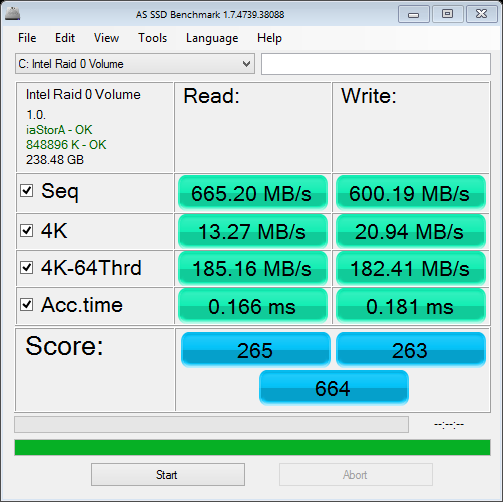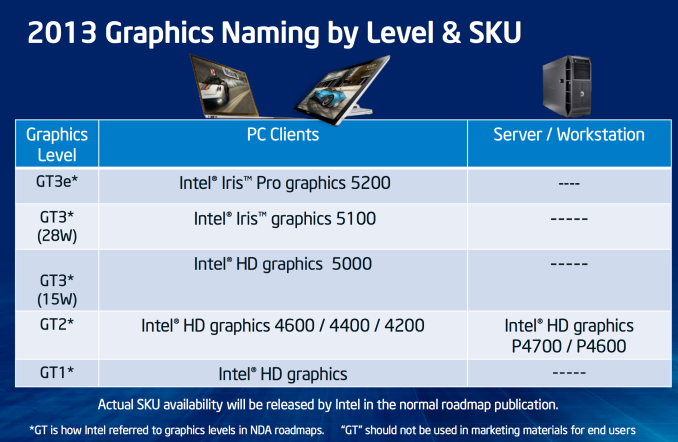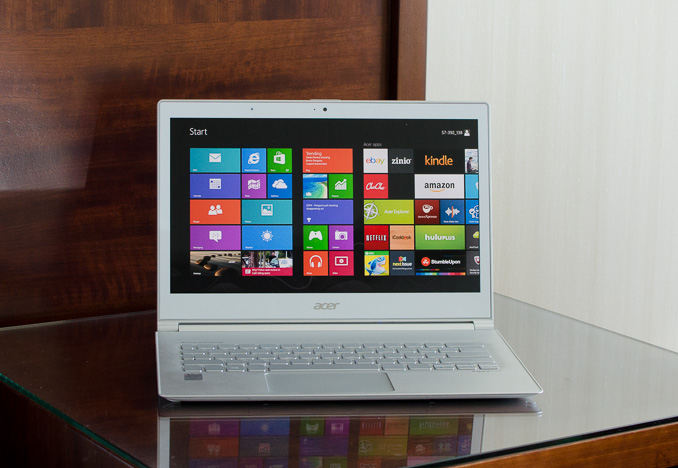The Haswell Ultrabook Review: Core i7-4500U Tested
by Anand Lal Shimpi on June 9, 2013 9:00 AM ESTHaswell ULT Graphics
As I mentioned in our Iris Pro review, Intel’s 128MB eDRAM die (codename Crystalwell) isn’t available on any dual-core parts, excluding it from Haswell ULT. Intel will offer both GT2 and GT3 GPU (20EU/40EU) implementations however. With max GPU clocks below 1100MHz, these parts are devoid of Iris Pro branding and are instead referred to as Intel HD Graphics.
The Test System and Haswell ULT SKUs
Before Computex, Acer announced the 2nd generation Aspire S7 based on Haswell ULT. I managed to get my hands on an early version of the new S7 and that will serve as the platform for the performance and battery life comparisons going forward.
I’ll do a separate piece, likely post-Computex, on the new S7 but I did want to share some preliminary thoughts about the machine here. The 2nd generation S7 looks a lot like the Ivy Bridge model. The chassis retains the Gorilla Glass covered display backing, aluminum base and capacitive touch screen. The Aspire S7 is still a beautiful notebook and shows huge progress from where Acer was just a few years ago. Despite the similarities, the 2nd generation Aspire S7 does come with some much needed tweaks and enhancements.
Acer started with the backlit keyboard, and increased key travel almost to the point of the MacBook Air. I didn’t have a ton of experience with the previous generation model, but this one feels a millimeter or so short of the travel on the MacBook Pro with Retina Display. Unfortunately there’s still no function lock, which means that things like Alt+F4 are still three-key combinations. The clickpad is powered by Elan, although I’ve heard murmurings of Acer switching to Synaptics going forward. Synaptics remains the closest to providing an Apple-like solution for clickpad performance, although even its solutions still need a little more work. Ergonomically the S7’s clickpad is recessed into the chassis just slightly more than I’d like.
The display was the target of major attention as well. By default the new Aspire S7 comes with a 13.3-inch 1920 x 1080 panel, however some models will offer an optional 2560 x 1440 panel instead. Unfortunately my sample only had the 1080p panel, but I’ve seen the 1440p version up close and it’s very impressive. I’m glad to see more PC notebook vendors not only go beyond 1366 x 768, but also exceed 1080p. Now all we need is for Microsoft to do a better job of handling high-DPI monitors in desktop mode.
Internally, my sample has a Core i7-4500U. The 4500U is the spiritual successor to the Core i7-3517U from our 1st generation Aspire S7 review unit. A look at the high level specs points to only a 100MHz reduction in base frequency, but identical max turbo frequencies. On the GPU side, there’s an increase in the number of EUs but relatively similar max operating frequencies. Based on the EU and clock differences, the max increase in graphics performance should be limited to around 19.5% (assuming both Haswell and Ivy Bridge are capable of hitting the same GPU turbo frequencies with the same regularity). I’m very eager to get my hands on an Ultrabook based on Intel’s GT3/HD 5000/Iris 5100, however that will have to wait for another day.
| Intel 4th Gen Core i7/i5/i3 Dual-Core U-Series Processors | ||||||||
| Model | Core i7-4650U | Core i7-4550U | Core i7-4500U | Core i5-4350U | Core i5-4250U | Core i5-4200U | Core i3-4100U | Core i3-4000U |
| Cores/Threads | 2/4 | 2/4 | 2/4 | 2/4 | 2/4 | 2/4 | 2/4 | 2/4 |
| CPU Base Freq | 1.7 | 1.5 | 1.8 | 1.4 | 1.3 | 1.6 | 1.8 | 1.7 |
| Max SC Turbo | 3.3 | 3.0 | 3.0 | 2.9 | 2.6 | 2.6 | n/a | n/a |
| Max DC Turbo | 2.9 | 2.7 | 2.7 | 2.6 | 2.3 | 2.3 | n/a | n/a |
| TDP | 15W | 15W | 15W | 15W | 15W | 15W | 15W | 15W |
| HD Graphics | 5000 | 5000 | 4400 | 5000 | 5000 | 4400 | 4400 | 4400 |
| GPU Clock | 200-1100 | 200-1100 | 200-1100 | 200-1100 | 200-1000 | 200-1000 | 200-1000 | 200-1000 |
| L3 Cache | 4MB | 4MB | 4MB | 3MB | 3MB | 3MB | 3MB | 3MB |
| DDR3/DDR3L | 1600 | 1600 | 1600 | 1600 | 1600 | 1600 | 1600 | 1600 |
| vPro/TXT | Yes | No | No | Yes | No | No | No | No |
| VT-d | Yes | Yes | No | Yes | Yes | No | Yes | Yes |
| Intel SBA | Yes | Yes | Yes | Yes | Yes | Yes | ||
Like all 15W Ultrabooks, the Aspire S7 uses a single fan to cool the Haswell CPU. You will hear the fan ramp up, and the bottom of the chassis gets warm, but neither were uncomfortable to me personally.

Acer continues to use an internal RAID-0 of Lite On mSATA SSDs. In this case there are two Marvell 88SS9174 based SSDs in RAID-0. The combination yields a peak sequential throughput of 665MB/s, which is pretty fast for an Ultrabook. Although I’d personally prefer a simpler, non-RAID setup, I can understand why Acer would be tempted to do something like this.
The SSDs in the S7 now support device sleep (DEVSLP), which boasts incredibly low power consumption when the system is asleep. The way it works is pretty neat. Using HIPM and DIPM, SSD controllers can do a good job of powering down big blocks of the controller however the SATA PHY can’t be powered down otherwise you risk losing communication with the drive itself. The device sleep spec calls for an out of band signal telling the SSD when it can go to sleep and when it can wake up. Since the signal is out of band, the SATA PHY doesn’t need to be active for communication, and thus the SATA PHY itself can power down. Lite On tells me that in DEVSLP mode, its SSDs will draw somewhere around 2mW of power - that’s compared to around 100mW when they’re in DIPM slumber. With Haswell, Intel is very focused on driving power outside of the CPU as low as possible - DEVSLP is a very good example of doing just that.
Acer dramatically increased the battery capacity of the Aspire S7 from 35Wh up to 46Wh. Despite the higher capacity battery there’s no increase in weight. The 13.3-inch S7 still weighs around 2.86 lbs.













87 Comments
View All Comments
StealthGhost - Sunday, June 9, 2013 - link
Is PCMark 8 Home less demanding than 1080p video? If not, it doesn't seem like the Asus can call itself an Ultrabook.Still, impressive gains in battery life. I hope this will carry over, to some extent at least, into the CPUs that will be in laptops like the MacBook Pros. Guess we will have to see when that review comes out =)
StealthGhost - Sunday, June 9, 2013 - link
*AcerDeath666Angel - Sunday, June 9, 2013 - link
As far as I know the Ultrabook specs don't define a minimum luminance for the display. So Anand's test isn't relevant for the Ultrabook spec.axien86 - Sunday, June 9, 2013 - link
Laptopmag just reviewed the Sony Vaio based on the i7-4500u and they also noted that performance wise the Haswell offered marginal improvement over Ivy Bridge laptops, while battery life was indicated as improved.One important characteristic that most laptop users want to know is regards to heat and fan noise. Laptopmag found that the Haswell i7-4500u based Sony Vaio found that the back of the laptop "reached a more troubling 110 degrees." They also found fan noise was definitely noticeable in a quiet room just running Word and a Youtube video.
http://www.laptopmag.com/reviews/laptops/sony-vaio...
The question is, why hasn't Anandtech run extensive temperature and noise characteristic analysis on Intel Haswell processors and your current laptop?
Kristian Vättö - Sunday, June 9, 2013 - link
Likely because of lack of time. As Anand said in the article, he got the unit while in Computex, so basically he did the review between meetings. I'm pretty sure he didn't have the equipment with him to do temperature or noise tests properly but I'm sure this is something that will be tested in later reviews.Also, keep in mind that heat and fan noise are system-dependent. If the Vaio has poor cooling, then it will be hot and loud but that's not Haswell's fault (I'm not saying this is the case but we obviously need more reviews before any conclusions can be drawn).
mavere - Sunday, June 9, 2013 - link
"The question is, why hasn't Anandtech run extensive temperature and noise characteristic analysis on Intel Haswell processors and your current laptop?"The WHr of battery that a laptop consumes is the exact same thing as its heat output.
Anand is trying to test the Haswell platform, not the design deficiencies of any specific manufacturer. Sony's problems are its own.
n13L5 - Sunday, June 9, 2013 - link
Cause they had to run their test in Taiwan with a borrowed machine?I was rather disturbed by the temperature of Sony's Vaio Pro, as well as the instability of the carbon case, which must be paper thin... And their keyboard backlight has the worst bleed I've ever seen, they should have a look at Lenovo and Samsung keyboards...
Well, I'll be waiting for more tests and the ULT Haswell with the Iris 5100 GPU. Maybe that'll rack up a high enough temperature to fry a steak.
akbisw - Monday, June 10, 2013 - link
Sony has terrible cooling system in their laptops in general. The worst I have seen done by any manufacturer. Even my my old acer before their "reiteration" had better cooling design than current VAIO systems.Dnann - Friday, June 14, 2013 - link
He probably didn't have the time considering the circumstances...DanNeely - Sunday, June 9, 2013 - link
The fact that companies historically known for horrible battery life are getting good results out of Haswell with Intel's help is promising; but starting from such a horribly low baseline makes getting gains much easier. I'm much more interested in seeing what companies who've historically offered good battery run times will be able to do with Haswell.